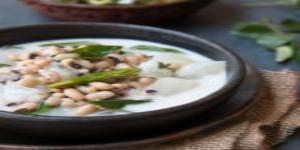
Scope
Kootu is a lentil and vegetable dish, particularly in Tamil and Kerala cuisines. The etymology for kootu is derived from the Tamil word “kootu” which means “add” i.e. vegetable added with lentils form the dish, which is semi-solid in consistency. Like the curd or moru based dishes, kootu are also side dishes, similar to dhal fry, pachadi and curry, sometimes devoid of the tangy or sourness of tamarind or curds. Kootu is a tasty side dish as well as a very healthy food.
The dish is noted for its nutty and complex flavors and textures, owing to the liberal addition of lentils and coconuts. It is typically less watery than sambhar, but more so than dry stir-fries. All kootus by default have some vegetables and lentils, but many variations of kootu exist.
? Poricha Kootu: A kootu made with urad dhal and pepper is called poricha (means “fried” in Tamil) kootu. Fried urad dhal, pepper, few red chilies, some cumin and fresh coconut are ground together. Moong dhal and the cut vegetables are cooked separately. Then, the ground paste, cooked vegetables and moong dhal are mixed and heated. Vegetables such as beans and snake gourd are common ingredients in this kootu.
? Araichivita Kootu: A kootu which has a powdered (freshly ground) masala in it; the word araichivita in Tamil literally translates to “the one which has been ground and poured.” The ground paste is a mixture of fried urad dal, cumin seeds and coconut.
? Araichivita Sambar: The chopped vegetables and toor dhal are cooked separately. Then, the ground paste, cooked vegetables and dal are heated together to which a ground paste of coconut, Bengal gram, coriander, red chilies, a few pepper corns, a piece of cinnamon is added. The dish is completed with a seasoning of mustard.
https://en.wikipedia.org/wiki/Koottu
Fundamental Concepts and Principles
Big Pumpkin – 10 palam
Red Beans – ? padi
Salt – ? palam
Coconut – 1
Coconut Oil – 1½ palam
Water – 1½ palam
Method
1. Select tender pumpkin and cut it into long pieces of approximately 1 inch long, ½ inch broad and as thick as a paddy and take in a vessel. Take beans in a vessel with water and cook.
2. When beans are cooked, add pumpkin pieces with little water and cook well.
3. Powder the salt and add it to the avial. Shred the coconut.
4. Take out coconut milk, add to the cooked vegetables and beans etc. If we want we can mix coconut oil with water and add it to the Olan.
Hindu Compliance Body
The Hindu compliance body was established under the executive order of The Supreme Pontiff of Hinduism, dated August 14, 2020, order number 10010, under the title Reviving the Hindu Compliance System and Body
to create, promote, spread and teach the standard procedures for all products and services that are in compliance Hindu Shastras.
Copyright
HCS has the copyright of all its publications. No part of these publications may be reproduced in any form without the prior permission in writing to HCS. This does not preclude the free use, in the course of implementing standard, of necessary details mentioned above. Enquiries related to copyrights to be addressed to KAILASA.
